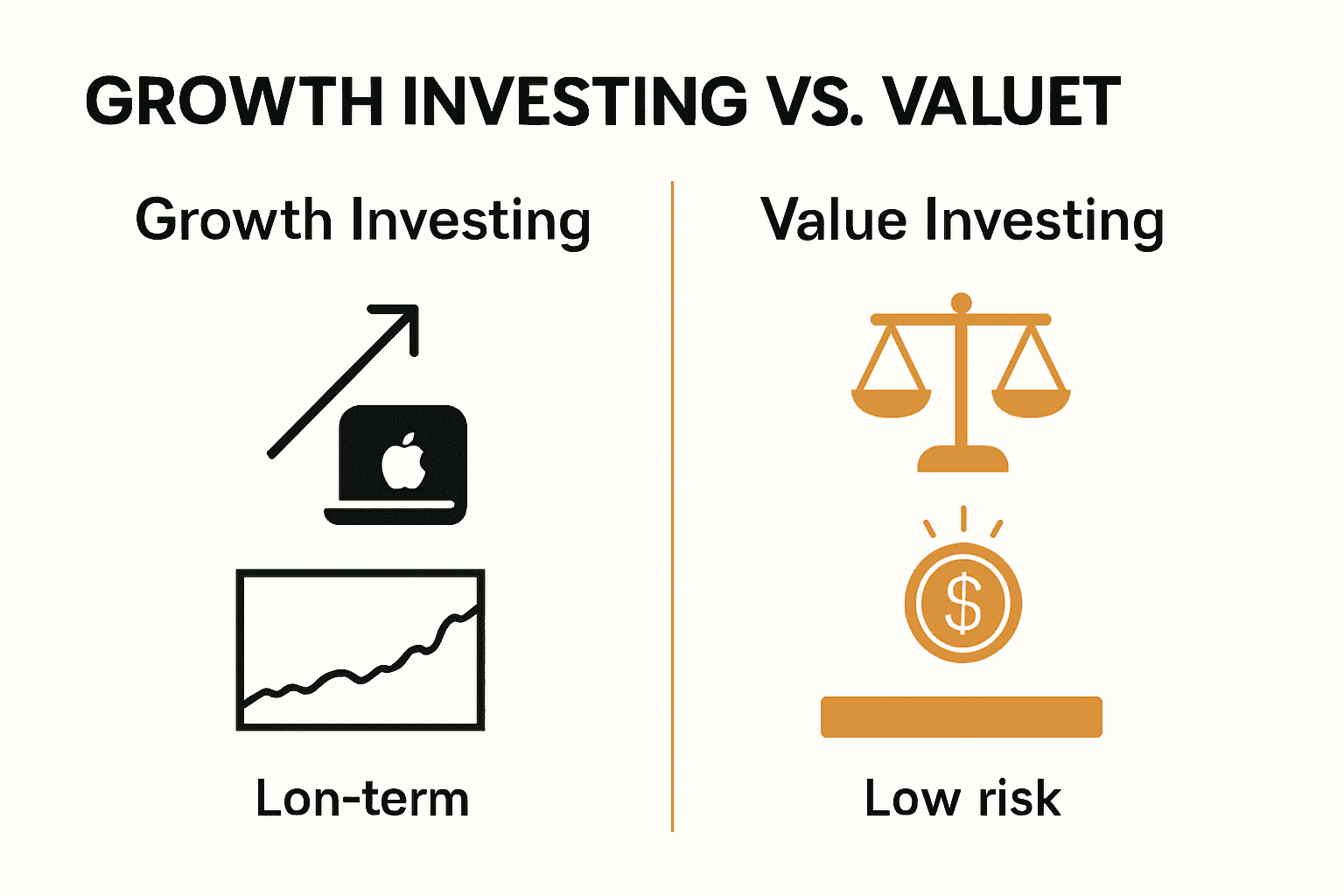Did you know that over 80% of the top-performing U.S. stocks in the past decade were classified as growth stocks? People increasingly want investments with the potential to deliver far greater returns over time rather than settling for steady income right now. Growth investing attracts attention because it zeroes in on companies expected to expand rapidly, often in technology, healthcare, or shifting industries. Understanding this approach can help you spot opportunities that traditional methods often overlook.
Key Takeaways
| Point | Details |
|---|---|
| Investment Strategy | Growth investing targets companies with high potential for future growth rather than current profitability, prioritizing long-term capital appreciation. |
| Key Traits | High-growth stocks are characterized by unique competitive advantages, strong technological infrastructure, and consistent above-average revenue growth. |
| Investment Process | Successful growth investing requires comprehensive research, long-term focus, and the ability to handle market volatility and uncertainties. |
| Distinguishing Factors | Understanding the differences between growth and value investing aids in building a balanced portfolio that adapts to changing market conditions. |
Table of Contents
- What Is Growth Investing Meaning
- Key Traits Of High‑Growth Stocks
- How Growth Investing Works
- Types Of Growth Investment Strategies
- Risks And Financial Implications
- Growth Versus Value Investing
What Is Growth Investing Meaning
Growth investing represents a strategic approach where investors target companies with substantial potential for future expansion, prioritizing long-term capital appreciation over immediate financial returns. According to research from Saxo, this investment strategy fundamentally differs from traditional value investing by focusing on companies expected to grow rapidly.
Typically, growth investors seek out businesses with competitive advantages in dynamic sectors like technology and healthcare. These companies often demonstrate key characteristics:
- Consistently reinvesting earnings back into the business
- Showing strong innovation potential
- Exhibiting above-average revenue and earnings growth rates
- Possessing unique market positioning
As research indicates, growth stocks are particularly attractive because they offer long-term capital appreciation potential. Unlike dividend-focused investments, these companies prioritize expanding their market presence and technological capabilities. Investors in growth stocks are essentially betting on a company’s future potential, understanding that current profitability might be limited but future prospects are promising.
The core philosophy of growth investing revolves around identifying emerging businesses with transformative capabilities. Smart investors look beyond current financial statements, examining factors like management quality, market disruption potential, and scalable business models that could generate substantial returns in the coming years.
Key Traits Of High‑Growth Stocks
High-growth stocks are distinguished by several critical characteristics that set them apart in the investment landscape. Research from recent technological studies reveals that beyond traditional financial metrics, technological capabilities play a pivotal role in identifying companies with exceptional growth potential.
Key traits that investors should look for include:
- A unique competitive advantage that differentiates the company from competitors
- Strong technological infrastructure, including:
- Robust patent portfolios
- Strategic positioning within technology ecosystems
- Ability to attract and maintain a loyal customer base
- Consistent revenue growth that outpaces industry averages
According to research analysis, high-growth companies typically possess a unique selling point that enables them to build a loyal customer base. This loyalty translates into sustained sales growth and market expansion. The most promising high-growth stocks demonstrate not just financial performance, but also innovative capabilities that position them to disrupt existing markets or create entirely new ones.
Investors seeking high-growth opportunities should pay close attention to companies that combine technological innovation with strategic market positioning. The most successful high-growth stocks are those that can continuously evolve, adapt to changing market conditions, and maintain a clear vision for future expansion. By focusing on companies with strong fundamentals, innovative potential, and a track record of strategic growth, investors can identify stocks with significant long-term appreciation potential.

How Growth Investing Works
Growth investing operates on a strategic approach that prioritizes potential future performance over current financial metrics. According to research from Saxo, investors deliberately accept higher valuations with the expectation that companies will reinvest their earnings to drive significant future expansion and capital appreciation.
The growth investing process typically involves several critical steps:
- Conducting comprehensive fundamental research
- Identifying companies with strong growth potential
- Analyzing sectors with transformative technological capabilities
- Selecting individual stocks or growth-focused investment vehicles
- Maintaining a long-term investment perspective
Research from Business Yield emphasizes that successful growth investing requires substantial patience. Investors must understand that promising companies might take years to deliver substantial returns. This approach contrasts sharply with short-term trading strategies, focusing instead on businesses demonstrating consistent innovation, market expansion potential, and strategic reinvestment of profits.
Investors can implement growth investing through multiple strategies, including selecting individual high-potential stocks, investing in growth-oriented mutual funds, or utilizing exchange-traded funds (ETFs) that track high-growth sectors. The key is maintaining a disciplined approach that balances potential rewards with calculated risk assessment, always keeping the long-term growth trajectory at the forefront of investment decision-making.
Types Of Growth Investment Strategies
Growth investment strategies encompass a range of sophisticated approaches designed to maximize potential returns from high-growth companies. According to research from Saxo, investors can leverage several strategic methods to optimize their growth-focused portfolios.
Key growth investment strategies include:
- Sector-Specific Investing
- Technology sector growth
- Healthcare innovation investments
- Renewable energy emerging markets
- Targeted Stock Selection
- Using advanced growth stock screeners
- Analyzing competitive advantages
- Identifying sustainable business models
Research highlights that successful growth investing requires more than just picking promising stocks. Investors must employ sophisticated techniques like dollar-cost averaging, which involves consistently investing fixed amounts over time to mitigate market volatility and reduce the impact of short-term price fluctuations.
The most effective growth investment strategies focus on building a diversified portfolio that balances potential high-growth opportunities with calculated risk management. By combining sector diversification, systematic investment approaches, and continuous research, investors can create robust growth-oriented portfolios that capitalize on emerging market trends and technological innovations. Learn more about building a comprehensive investment strategy to maximize your long-term financial potential.
Risks And Financial Implications
Growth investing carries inherent risks that investors must carefully evaluate before committing capital. According to research from Saxo, the strategy involves significant potential challenges that can impact overall investment performance.
Key risks in growth investing include:
- Market Volatility
- Sharp price fluctuations
- Sector-specific economic sensitivity
- Rapid value changes based on investor sentiment
- Investment Uncertainty
- Potential overvaluation
- Unmet growth expectations
- Extended periods without profitability
Research highlights that financial implications extend beyond immediate market movements. Investors must develop a high tolerance for uncertainty, understanding that growth stocks can experience significant price volatility. Companies focusing on reinvestment might not generate immediate profits, requiring a long-term perspective and robust risk management approach.
Successful growth investors need comprehensive risk management strategies to navigate these complex financial landscapes. By diversifying investments, maintaining realistic expectations, and continuously monitoring market trends, investors can mitigate potential downsides while positioning themselves to capture substantial long-term growth opportunities.
Growth Versus Value Investing
Growth and value investing represent two distinct investment philosophies that approach stock selection from fundamentally different perspectives. According to Morningstar research, historical data reveals fascinating cyclical patterns of performance between these two investment strategies, with leadership often shifting based on economic conditions.
Key differences between growth and value investing include:
- Growth Investing Characteristics
- Focus on companies with high potential expansion
- Higher price-to-earnings ratios
- Emphasis on future revenue potential
- Value Investing Characteristics
- Targeting undervalued companies
- Lower price-to-earnings ratios
- Prioritizing current financial fundamentals
Research from Kiplinger suggests that while growth has recently outperformed value, historical trends indicate value investing can deliver superior long-term returns. The complexity arises from overlapping definitions and the challenge of obtaining pure exposure through broad indices, which often recommends a nuanced, blended investment approach.
Investors should recognize that these strategies are not mutually exclusive. The most sophisticated investment portfolios often incorporate elements of both growth and value investing, adapting to changing market conditions and individual financial goals. This flexible approach allows investors to balance potential high-growth opportunities with more stable, fundamentally sound investment choices.

Here’s a side-by-side comparison of growth investing and value investing characteristics:
| Characteristic | Growth Investing | Value Investing |
|---|---|---|
| Main Focus | Future company expansion | Undervalued current companies |
| Typical P/E Ratios | High | Low |
| Profit Timeline | Long-term appreciation | Steady current returns |
| Key Metrics | Revenue growth Innovation |
Book value Dividends |
| Sector Tendencies | Technology Healthcare |
Financials Industrials |
| Risk Profile | Higher volatility | Traditionally lower risk |
Ready to Transform Your Growth Investing Strategy?
Are you struggling to identify the next high-growth opportunity or feeling overwhelmed by market volatility and risk? Growth investing offers the promise of long-term rewards, but finding reliable strategies and building a strong portfolio are real challenges for most investors. You are not alone if you worry about picking the right stocks or managing uncertainty while searching for future market leaders.
At finblog.com, you’ll discover practical guides, in-depth analysis, and expert support to simplify your growth investing journey. Leverage free resources that help you understand high-growth sectors, strategic portfolio building, and risk management—exactly what today’s article explored. If you are ready to take control of your financial future, start here and unlock expert advice tailored to your investment goals. Do not wait. Make your next move and connect with our proven strategies and personalized guidance today.
Frequently Asked Questions
What is growth investing?
Growth investing is a strategy where investors target companies with significant potential for future expansion, focusing on long-term capital appreciation rather than immediate returns. This approach often prioritizes companies in dynamic sectors such as technology and healthcare.
What are the key characteristics of high-growth stocks?
High-growth stocks typically exhibit unique competitive advantages, strong technological infrastructure, the ability to attract a loyal customer base, and consistent revenue growth that outpaces industry averages.
How does growth investing work?
Growth investing involves a strategic approach that prioritizes potential future performance over current financial metrics. Investors conduct comprehensive research to identify companies with strong growth potential and maintain a long-term investment perspective.
What are the main risks associated with growth investing?
The main risks of growth investing include market volatility, potential overvaluation, and investment uncertainty. Companies that focus on reinvestment might not generate immediate profits, making it essential for investors to adopt a long-term perspective and robust risk management strategies.










